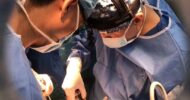Test your medicine knowledge with the MKSAP challenge, in partnership with the American College of Physicians.
A 48-year-old woman is evaluated at a follow-up appointment for elevated liver chemistry tests over the preceding 6 months. She reports no symptoms. She has type 2 diabetes mellitus and hypertension. Her family history is unremarkable. She drinks two glasses of wine one or two times per month. Her medications are metformin and lisinopril.
On physical examination, vital signs are normal; BMI is 31. No spider angiomata, palmar erythema, splenomegaly, abdominal distention, or lower-extremity edema is noted. Laboratory studies show alkaline phosphatase 96 U/L, alanine aminotransferase 85 U/L, and aspartate aminotransferase 74 U/L, and a test for anti–smooth muscle antibody is positive (1:20 titer).
Results of other studies, including hepatitis C antibody, hepatitis B surface antigen, iron saturation, α1-antitrypsin phenotype, tissue transglutaminase IgA antibody, antimitochondrial antibody, and IgG, are within normal limits.
On ultrasonography, the liver is hyperechoic and enlarged.
Which of the following is the most likely diagnosis?
A. Antimitochondrial antibody–negative primary biliary cholangitis
B. Autoimmune hepatitis
C. Nonalcoholic fatty liver disease
D. Primary sclerosing cholangitis
MKSAP Answer and Critique
The correct answer is C. Nonalcoholic fatty liver disease.
The most likely diagnosis is nonalcoholic fatty liver disease (NAFLD). Up to 108 million Americans have NAFLD, which far exceeds the prevalence of any other form of chronic liver disease. Risk factors include obesity, diabetes mellitus, insulin resistance, hypertension, and hyperlipidemia. This patient has three risk factors for NAFLD, as well as an enlarged liver on physical examination. Her elevated alanine aminotransferase and aspartate aminotransferase levels are within the typical range for patients with NAFLD. Alkaline phosphatase (ALP) levels may be slightly elevated as well, typically less than 2 to 2.5 times the upper limit of normal. The finding of a hyperechoic liver on ultrasonography is also consistent with NAFLD. Because other liver diseases may also result in hepatic steatosis, patients with elevated liver chemistries and suspected nonalcoholic steatohepatitis should be evaluated to exclude other causes of chronic liver disease.
The diagnosis of primary biliary cholangitis (PBC) is generally made on the basis of a cholestatic liver enzyme profile in the setting of a positive antimitochondrial antibody test. The predominant liver enzyme abnormality is an increase in serum ALP levels, but a mild to moderate increase in aminotransferase levels is also seen. Antimitochondrial antibody–negative PBC accounts for about 10% of cases of PBC. This patient’s liver chemistry profile is hepatocellular (elevations primarily of aminotransaminase levels), not cholestatic, making PBC unlikely.
Although this patient has a positive anti–smooth muscle antibody test, the low titer alone is not diagnostic of autoimmune hepatitis. Autoimmune hepatitis is typically accompanied by higher autoantibody titers and elevated γ-globulin levels. It requires a liver biopsy to establish the diagnosis. Between 20% and 30% of patients with NAFLD exhibit low-titer autoantibodies.
This patient has a minimally elevated ALP level, which helps to exclude primary sclerosing cholangitis (PSC) or PBC. In addition, the patient’s risk factors and ultrasound findings make these diagnoses unlikely. MR cholangiopancreatography is required to diagnose PSC.
Key Point
- Nonalcoholic fatty liver disease is the most common cause of abnormal liver test results in the United States.
This content is excerpted from MKSAP 18 with permission from the American College of Physicians (ACP). Use is restricted in the same manner as that defined in the MKSAP 18 Digital license agreement. This material should never be used as a substitute for clinical judgment and does not represent an official position of ACP. All content is licensed to KevinMD.com on an “AS IS” basis without any warranty of any nature. The publisher, ACP, shall not be liable for any damage or loss of any kind arising out of or resulting from use of content, regardless of whether such liability is based in tort, contract or otherwise.



















![Why humanity matters in medicine [PODCAST]](https://kevinmd.com/wp-content/uploads/Gemini_Generated_Image_rjwfp8rjwfp8rjwf-190x100.png)
![How to prepare for your death [PODCAST]](https://kevinmd.com/wp-content/uploads/Design-1-190x100.jpg)
